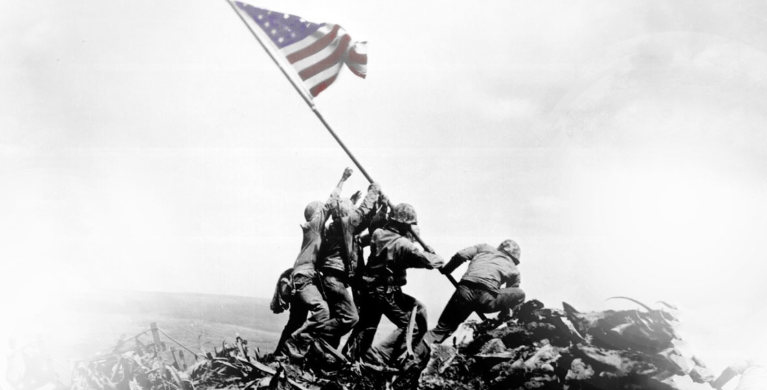In the short history of our country, the United States rose to global military dominance — yeah, I said it. Come at me, China.
But the road to the top was paved with the blood of good men and women. Looking back, there are some pivotal battles we remember with solemn pride and a little bit of hoo-rah. Let’s check out 10 of the most intense battles in United States history.
10. The Battle of Chosin
This blown bridge at Funchilin Pass blocked the only way out for U.S. and British forces withdrawing from the Chosin Reservoir in North Korea during the Korean War. Air Force C-119 Flying Boxcars dropped portable bridge sections to span the chasm, allowing men and equipment to reach safety.(Photo by U.S. Air Force)
The Battle of Chosin Reservoir was one of the defining battles of the Korean War and the stuff of legend in the Marine Corps. In the Fall of 1950, U.N. Forces under the command of General MacArthur had almost captured the entirety of North Korea when they were attacked by thousands of Chinese Communist soldiers. The U.S. X Corps was forced to retreat and by mid-November the 1st Marine Division and elements of the 7th Infantry Division found themselves surrounded, outnumbered, and at risk of annihilation in the high North Korean Mountains at the Chosin Reservoir. Their only way out was a fighting retreat back to the coast.
Although as Chesty Puller put it, they weren’t retreating, they were “fighting in the opposite direction.”
Over the course of the next 17 days, the Marines and soldiers fought the Chinese — and bouts of frostbite — with fierce determination and epic endurance. They broke through the enemy’s encirclement and even rebuilt a bridge the Chinese destroyed using prebuilt bridge sections dropped by the U.S. Air Force.
By the end of the battle, the U.S. Marines suffered 836 dead and roughly 10,000 wounded. The Army had 2,000 dead and 1,000 wounded. The Chinese had the most catastrophic losses. Six out of their ten divisions were wiped out and only one would ever see combat again. Although exact numbers are not known, historians estimate that anywhere between 30,000 and 80,000 Chinese were killed.
Although technically a loss for the Marines, the Battle of Chosin Reservoir lives on in memory as an example of the Marine fighting spirit and the ability to find strength even when the odds are stacked against them.
9. The Battle of Antietam
A year and a half into the Civil War, President Abraham Lincoln needed a Union victory. He finalized the Emancipation Proclamation during the summer but his cabinet feared it would be too difficult to enforce after a string of northern losses, including the Second Battle of Bull Run (known as the Battle of Manassas to the rebels).
Lincoln charged Major General George B. McClellan with the defense of Washington D.C. against Confederate General Robert E. Lee’s first invasion of the North. Earlier in the month, Lee divided his men, sending General Thomas “Stonewall” Jackson to capture Harper’s Ferry. Following Jackson’s success, Lee decided to make a stand in Maryland at Antietam Creek.
After two days of posturing, fighting began early in the morning on Sep. 17, 1862, and lasted well past sundown, with staggering casualties on both sides and no ground gained. The next day, both armies gathered their dead and wounded and Lee retreated south.
It was the bloodiest one day battle in American history, with 23,000 casualties from both sides and nearly 4,000 dead.
Sticking with the Civil War, let’s move on:
8. The Battle of Gettysburg
The Battle of Gettysburg was not only the largest battle of the Civil War, it remains the largest battle ever fought in North America.
Confederate General Robert E. Lee had just won a decisive victory against Union General George Meade’s Army of the Potomac in Virginia. Wanting to capitalize on the recent victory, Lee led his troops on a second invasion into the Northern states to defeat the Union on their own soil and hopefully gain recognition of the confederacy by European countries.
General George Meade’s Army of the Potomac pursued Lee’s Army of Northern Virginia and the two forces met near Gettysburg on July 1, 1863. The Confederates outnumbered the Yankees at roughly 30,000 to 18,000. By the end of the first day, the Yankees were forced to retreat through town to cemetery ridge and Culp’s Hill.
By the next day, both sides had gained reinforcements. Meade now had roughly 94,000 soldiers in a fish hook formation, allowing him to successfully move troops from one front to another. Lee had roughly 72,000 soldiers wrapped around the fish hook.
The Confederates attacked first but at the end of the second day, the Union defense lines held strong.
On the 3rd day, Lee tried an aggressive attack to crush the federals. He sent General Pickett with approximately 12,500 men to crush the Union Army with a direct charge.
It turned out to be one of Lee’s most ill-fated decisions. Fifty percent of Pickett’s men were wounded or killed and the rest of his troops were forced to retreat.
Also read: 5 most humiliating defeats in military history
On July 4th, Lee and his men waited for the Yankees to attack — but they didn’t.
That night the Northern Army of Virginia began its retreat back to the South. His train of wounded men stretched 14 miles long. Lee’s greatest opportunity became his greatest failure and his hopes of European recognition for the Confederacy — and a quick end to the war — were dashed.
Casualties were high on both sides. The Union suffered around 23,000 casualties while the South suffered 28,000 — more than a third of Lee’s army.
The battle was the deadliest in the Civil War and prompted Lincoln’s iconic Gettysburg address four and a half months later at the dedication of the Soldiers’ National Cemetery.
Although the fighting continued for nearly two more years, Gettysburg was an irrevocable turning point in the war in the Union’s favor.
7. Hue City
The North Vietnamese captured the venerated capital city of Hue during the Tet Offensive, a coordinated series of attacks on over a hundred American and South Vietnamese positions countrywide.
The battle to regain Hue began in February 1968 and lasted nearly a month, as Marines ferociously drove North Vietnamese and Communist Viet Cong forces from the city.
The Perfume River divided the city of Hue in two. To the north was the Citadel, a three-square mile fortress surrounded by walls 30-feet high and up to 40-feet thick, with a moat on three sides and the Perfume River on the 4th. To the south, the smaller and more modern section of Hue was connected to the Citadel by a bridge.
U.S. Marines and soldiers were tasked with clearing out the entrenched enemy in the southern portion of the city, while the Army of the Republic of Vietnam (ARVN) would clear out the Northern portion and the citadel.
Untrained for urban combat, U.S. battalions had to come up with tactics and techniques on the spot — while facing a brutal enemy. The process was methodical and casualty heavy. They went from house to house and room to room to gain ground. Speed, surprise, and shock were essential to achieve victory.
After clearing the south side, U.S. battalions broke into the Citadel from the bridge to assist ARVN troops.
Finally on Feb. 24, the South Vietnamese flag flew over the citadel. On March 2, the longest sustained infantry battle the war had seen to this point was officially declared over.
Casualties were high on both sides.
The U.S. suffered 216 dead and 1364 wounded. South Vietnamese losses totaled 384 dead and 1,830 wounded with thousands of civilians were caught in the the cross-fire or murdered. The North Vietnamese casualties included 5,000 dead and countless more wounded.
Virtually all of Hue was destroyed, leaving roughly 100,000 homeless.
While technically a win for the U.S. and South Vietnamese, the news coverage of the event shocked the American population and broke their faith in the war.
U.S. troops would not experience that intensity of urban fighting again for another 36 years until the second battle of Fallujah, which is number six on our list.
6. Second Battle of Fallujah

The Second Battle of Fallujah was the bloodiest battle American troops fought in the entire Iraq conflictand the deadliest battle for the Marine Corps since Hue City in 1968. From November through December 2004, a joint American, British, and Iraqi-government offensive fought to clear the insurgents from their Anbar province stronghold.
An estimated 4000 enemy combatants were in the city when the fighting began — it’s even suspected that al’Qa’eda terrorist Abu Musab al-Zarqawi held his headquarters there. They fortified their defenses before the attack, preparing spider holes, traps, and concealed IEDs throughout the town. They created propane bombs hidden in buildings, cut off access to escape routes and roofs, and designed fields of fire where they believed coalition forces would maneuver.
Nearly 70% of the civilian population fled the city, reducing civilian casualties and allowing coalition forces to launch their assault. Army, Marine, and Iraqi forces attacked with an air barrage, followed by an insertion of Marines and Navy Seabees, who bulldozed obstacles. The worst of the fighting continued for the first week, but insurgents resisted throughout the six-week campaign.
By the end of December, 82 US troops were killed with another 600 wounded. British and Iraqi forces sustained 12 killed with another 53 wounded. Over 2000 insurgents were killed while another 1200 were captured.
Keeping with Post-9/11, let’s talk about Afghanistan.
5. Battle of Sangin
IEDs peppered the landscape, killing or maiming hundreds. During the height of the fighting, there was daily contact with the enemy just meters outside allied FOBs. In October 2010, 3rd Battalion 5th Marines began a 7-month tour that would kill dozens of them in action and injure hundreds more, with at least 34 of them becoming single, double, or triple amputees. But the “Dark Horse” Marines made progress extending their security perimeter and clearing Highway 611, which allowed for the transportation and operation of future units.
Also read: 10 songs we listened to while “Bangin’ in Sangin”
By 2012, Sangin was transformed from a battlefield into a thriving rural town, but the price was over 100 British and American lives lost and hundreds more wounded. The Taliban continued to fight for Sangin, and today, the area remains in contention.
4. Operation Bolo
This is the only air-to-air fight we’ll cover. It’s decidedly less deadly than any other battle on this list, but the tactics and implications merit a discussion.
Operation Bolo was the biggest air battle in the Vietnam War and one of the most successful ambush actions in military history.
In the last months of 1966, the North Vietnamese Army’s Mig-21 Fishbed fleet had become more active and successful at intercepting the F-105 Thunderchief formations of the United States Air Force.
The F-105 “Thuds” were super-sonic fighter-bombers with the mission of destroying communist air defense systems. They did this in the role of the wild weasels, a group that would fly slow and low enough to bait the communist surface-to-air systems into targeting them, thus giving away the enemy position and allowing the Wild Weasels to attack and destroy.
But with the MiG-21 added to the fight, the Thuds were falling vulnerable to air-to-air attacks.
The U.S. Air Force decided they needed to neutralize the MiG threat. Air Force legend and World War II Ace Colonel Robin Olds designed a gutsy plan to accomplish this.
Known as Operation Bolo, the mission was to lure the enemy MiGs into battle by hiding supersonic F-4C jets among the slower and less-maneuverable Thud formations.
On Jan. 2, 1967, Olds and his formation of phantoms took to the cloudy skies to fly the F-105 bomb run. They kept to the F-105 speed and flew in the F-105 formation.
The NVA took the bait and engaged.
Popping up from the clouds, the Fishbeds attacked in pairs. Olds and his formation began a legendary dogfight, where U.S. forces exploited their tactical and technical advantage over the enemy.
Within 13 minutes, seven MiGs were destroyed — roughly half the NVA Mig -21 fleet. The Americans hauled ass back to Thailand with zero casualties.
In the next week, similar missions took out more communist aircraft. As a result, the North Vietnamese were forced to ground their aircraft for several months as they re-trained their pilots and sought new air defense tactics.
Colonel Olds remains the only U.S. Air Force ace with victories in both World War II and Vietnam.
To illustrate how terrible it can be when our birds are shot down, let’s move on to Somalia.
3. Battle of Mogadishu
On Dec. 9, 1992, eighteen hundred United States Marines arrived in Mogadishu, Somalia to help affect peace in the war-torn country. As part of Operation Restore Hope, the Marines supported international aid workers in the country for humanitarian aid operations, including food and supply distribution. In 1993, President Bill Clinton reduced the U.S. presence as the United Nations formally assumed responsibility for operations.
In June, however, Pakistani UN peacekeepers were ambushed by militias loyal to Somali warlord General Mohammad Farrah Aidid, and 24 UN soldiers from Pakistan were killed.
In response, the UN authorized the arrest of Aidid, and President Clinton dispatched 160 Army Rangers and Delta Force operators on a mission to capture the warlord and other leaders of his militia.
The operation went disastrously wrong. Two UH-60 Black Hawk helicopters were shot down and a brutal urban battle began. The first Black Hawk was struck by an RPG, killing the pilot and co-pilot in the crash, and injuring five more passengers, including one who would die later from his wounds. A rescue mission retrieved the rest of the survivors, but then the second Black Hawk was struck, killing three in the crash. Pilot Mike Durant survived, but his back and leg were broken and he was taken prisoner.
Two Delta Force operators, MSG Gary Gordon and SFC Randy Shughart, were killed attempting to rescue Durant, who was held prisoner for 11 days until his release was secured through diplomatic negotiations. Gordon and Shughart would be posthumously awarded the Medal of Honor for their actions.
President Bill Clinton immediately ordered the withdrawal of American troops from Somalia, and other U.N. countries followed suit, leaving the region unstable and without a functioning government.
2. Iwo Jima
Wrecked vehicles litter an Iwo Jima beach.(DoD photo by U.S. Navy Petty Officer 3rd Class Robert M. Warren)
In the final stretch of World War II, the allies sought to gain control of strategic islands in the Pacific. Iwo Jima was a barren Pacific Island located roughly 660 miles from Japan, making it an ideal forward-deployed location for the Allies and Axis powers alike. On Feb. 19, 1945, after three days of naval and aerial bombardments, which launched over sixty-eight hundred tons of bombs and twenty-two thousand shells, the first wave of United States Marines stormed Iwo Jima’s volcanic shores.
Over 21,000 Japanese were there to greet them, heavily entrenched in a complex network of underground tunnels and artillery positions. What followed was some of the most violent fighting of the Pacific in World War II, due in large part to the determination of the Japanese to die before they would surrender.
They burned any vegetation that might have provided the Marines with cover, then launched artillery fire at the Marines’ exposed positions. Naval Seabees got to work on U.S. artillery positions, forward command posts, and field hospitals — all while holding their own in the fight.
Read more: Marines get an official history lesson on Iwo Jima
The iconic raising of the American Flag over Mount Suribachi took place four days into the battle, but the fighting continued for a month. Marines used artillery and flamethrowers to destroy enemy defenses, and the final battle on March 26 included a massive attack against the Americans that ultimately came down to hand-to-hand combat.
In the end, nearly all of the Japanese defenders were killed, except for a couple hundred prisoners. Over 6000 Americans died helping to take the island, with 17,000 more wounded.
1. D-Day
D-Day was the largest air, land, and sea operation undertaken to date and a logistics marvel. One of the most important battles in World War II, it turned the tide of the conflict in the Allies’ favor and eventually led to their victory in Europe.
Allied forces had been planning D-Day for months. Codenamed Operation Overlord, its goal was to gain a strong foothold in continental Europe by landing thousands of Allied troops and supplies on the beaches of Normandy, France.
The original invasion date was set for May, but due to poor weather conditions it was postponed until June. Despite the continued poor weather, General Eisenhower, the Supreme Commander of the Allied Forces, gave the order to attack.
D-Day would commence on June 6, 1944.
On Eisenhower’s orders, roughly 176,000 troops embarked on their journey from England to France on 6,000 landing craft, ships, and other vessels.
Just before midnight, airborne troops parachuted into occupied France, surprising the Germans.
Air and naval bombardments were underway to weaken the German defenses before the main invasion began.
At 0630 local time, the land insertion struck across five sectors in a 60-mile coastal stretch of Normandy. British and Canadian troops overcame light opposition to capture Gold, Juno, and Sword beaches, as did the Americans at Utah. But the American G.I.’s at Omaha faced a tough fight.
The aerial and naval bombardment had done little to diminish the heavily fortified German defenses, both on the shore and on the cliffs above the beaches. Allied amphibious tanks were launched too far from shore and only 2 out of 29 made it to the beach. Many soldiers drowned in the waves, dragged down by the weight of their rucksacks, and many more were mowed down by the constant German fire.
Small groups of Americans managed to make it across the beach and traverse up the cliffs.
Allied casualties on June 6 have been estimated at over 10,000 killed, wounded, and missing in action, consisting of around 6,603 Americans, 2,700 British, and 946 Canadians.
By the end of the day, 155,000 Allied troops successfully stormed and held Normandy’s beaches. By Aug. 21, 1944, the allies had successfully landed over 2 million men in Northern France and suffered 226,386 casualties. German losses included over 240,000 casualties and 200,000 captured. Between 13,000 and 20,000 French civilians died, and many more were seriously wounded.
The success of the invasion was the beginning of the end of the war in Europe. It forced the Germans to fight a two-front war with the Soviets on the East and British, Canadian, and U.S. forces on the west.
The Nazi Third Reich would fall the following May.
This article was written with contributions by Megan Hayes.
This article originally appeared on We Are The Mighty
More From We Are The Mighty
5 Reasons Why Troops Stick Together After the Military
4 Reasons Why Showering On Deployment is Disgusting
7 of the Greatest Songs Every Veteran Knows
6 Things You’d Take Back Before Leaving the Military
6 Dumb Things Veterans Lie About on the Internet
Follow We Are The Mighty on Twitter
READ NEXT: 7 SEAL MIND HACKS TO TAKE ON ANYTHING



















